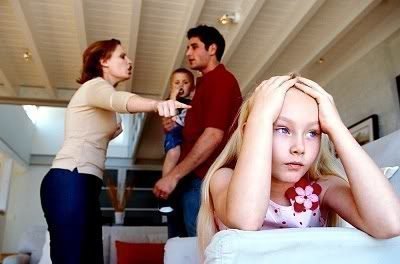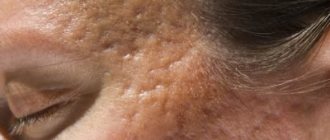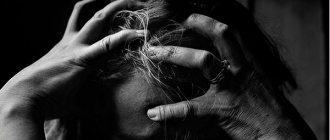The causes of stress lie in negative and positive situations: lack of control over emotions triggers a stressful state. Stressors are the “causative agents” of panic, depression and apathy.
Stressors cause different reactions, from panic to apathy
The types of stressors are determined by the psycho-emotional state of the victim and the experience. Such factors differ in the duration of exposure and frequency of repetitions.
What is stress?
Stressors trigger stress: more negative situations destroy a person’s defenses and cause a response. In conflictology, stressors are assigned a separate category of causes of protracted interpersonal conflicts.
Stress is a loss of control over emotions and one's own behavior. A state of increased tension occurs after prolonged exposure to stressors. By identifying the root cause of a person’s emotional instability, you can get rid of obsessive thoughts and fears.
Why do “irritants” appear?
Environmental stressors occur with a certain frequency or just once. Against the background of persistent depressive states, any reminder of a traumatic event triggers the body’s reaction. The impact of negative factors is enhanced by personal non-perception of oneself as an individual. Such stressors: hunger, cold, extreme environmental conditions can cause irreversible changes in the victim’s psyche.
What are the most dangerous causes of stress:
- change of main place of work,
- death of a loved one,
- physiological changes (diseases, injuries),
- injustice (feelings of guilt, envy, betrayal),
- unfavorable environmental factors.
Aggressive reactions due to stress can change a person’s life: deprive them of peace, destroy the family idyll, and disrupt harmony. Factors such as the death of a loved one or the loss of a loved one trigger strong rejection.
The victim of stress does not accept the tragedy, and denial of death leads to worsening mental disorders. The level of stress depends on a person’s individual resilience.
Psychological problems can arise due to poor adaptation of a person. Leaving your comfort zone causes stress for people of any age.

Envy, one of the causes of stress
1.2. Concept of austress and distress
The body's stress response to external factors is divided into two stages: austress and distress. Austress is the mobilization of the resources of the human body and its counteraction to negative reactions through the use of adaptation reserves. At this stage of stress, the activation of the nervous system does not exceed a critical level. Austress is called a beneficial stage of stress. Distress is a stage at which hypermobilization of the body occurs, activation of the nervous system significantly exceeds the critical level. Distress is called the dangerous stage of stress. Physiological studies have shown that a person must work using 40-60% of his capabilities (the body's energy resources). This is quite enough to successfully solve current problems. In extreme situations, a person can use up to 80% of all the energy and physiological capabilities of the body. Such a high degree of mobilization, which in physiology is designated by the term hypermobilization, cannot last long. Sooner or later, the body will need time to restore strength and energy. The remaining 20% is the body’s untouchable reserve, which can only be used in life-threatening situations. At the stage of distress, a person’s orientation is especially affected: he ceases to control the labor process. In this state, a person seems to be rushing about, working “through force”, not seeing anything that is happening around. The accuracy of a person’s movements decreases, he begins to make mistakes, and, as a result, an emergency situation occurs. The reaction to stressful situations is not the same for different people: people with a strong nervous system in a stressful situation only improve their performance, and they are not prone to distress. People with weak nervous systems easily become distressed. The emergence of distress is also facilitated by excessive alertness, haste, hot temper, and even a person’s bad character, because of which he often finds himself in conflict situations (i.e., a person’s personal and social qualities). When studying the problem of the influence of emotions on professional activity, it is necessary to distinguish between these two types of stress. A modern person must be prepared for stressful situations, there is no need to avoid stress, it is necessary to learn to live and cope with stress, to prevent it from moving to the stage of distress. A person’s emotional state and the associated activation of the nervous system depend on the degree of a person’s desire to solve difficult situations. When faced with a stressful situation, a person can experience two states: anxious anticipation and fear. Anxious anticipation arises in a situation of uncertainty, when a person is not sure that undesirable consequences for him will certainly occur. Psychologists believe that anxious anticipation is a subjective aspect of stress reactions that occur as a response to danger. Such a reaction to danger is necessary to prevent accidents and accidents, as it encourages the working person to be careful. Anxious expectation, if it is adequate to the danger, is an appropriate and useful state in work activity, it mobilizes the internal reserves of the human body and maintains constant readiness for undesirable situations. Anxious anticipation is a useful stage of stress, austress. But this same anxiety can develop into a real problem of fear of any extreme activity, which often happens, for example, among pilots. In addition, people exposed to continuous stressful situations during work often develop neurotic and psychosomatic diseases (stomach ulcers, cardiovascular diseases), and this can cause their professional unsuitability. Anxious anticipation is associated with a person’s ability to create various models in his imagination. We are talking about “internally playing out” various situations in the future and one’s own line of behavior in upcoming events. This “playing out” of situations is a necessary condition for solving problems that arise before the operator. It is when “playing out” possible unfavorable outcomes in certain events that a person develops a state of anxious anticipation, accompanied by significant vegetative changes in the body. For some people, wrote I. P. Pavlov, “the expectation of trouble can be stronger than the trouble itself.” But, as a rule, for people with a strong nervous system and balanced temperament, this anxious expectation at work gradually smoothes out and then completely disappears. Anticipation neurosis, according to many psychologists, occurs only in cases where a lost model with an unfavorable outcome becomes obsessive. To prevent the development of expectation neuroses, it is necessary, in the process of professional training, to create trust in technology, to cultivate confidence that if certain extreme and unforeseen situations arise, they can be dealt with. Another condition that can arise in an extreme situation is fear. Fear is a human reaction to danger that is inevitable. Fear causes a self-defense reaction in the body, which often manifests itself in complete inaction and passivity. Fear is distress. A person in a state of fear experiences so-called “emotional paralysis”; he experiences a feeling of emptiness in his head, a lack of thoughts, and loses the ability to logically comprehend what is happening. In this case, autonomic disturbances are observed in the form of pale face, rapid pulse, sweating, and trembling hands. But despite this, many operators in emergency situations act confidently, correctly, in accordance with the prevailing situation. This behavior reveals the moral qualities of the individual, his attitudes, which mobilize the person to make an adequate decision. In stressful situations, the moral and psychological factor and professional training play a significant role. But at the same time, it must be remembered that the load that falls on the psyche of an individual in an extreme situation is the load on his nervous system, which has its own limit of performance. This is precisely what can explain the fact that not all people develop acute affective reactions in extreme situations. The main condition for a successful exit from an extreme situation is active action. To understand the role of human activity in conditions of danger, consider an experiment conducted by American psychologists who study the influence of emotions on camera work. Scientists took a small group of dogs and conditioned them into a state of fear. To do this, the dogs were fixed motionless in a pen and at certain intervals a sound signal was given, after which the dogs received a painful electric shock. This group of dogs were then placed in an enclosure from which they were free to escape, and the beeping and electric shocks continued. At the same time, the dogs waited helplessly for a long time and endured pain, despite the fact that they could easily run out of the enclosure. Other dogs that did not pass the first stage of the experiment quickly ran away from the enclosure and avoided electric shocks. The first group of dogs developed a state of “learned helplessness.” A similar state of “learned helplessness” is observed in people who are repeatedly faced with situations that lead to inevitable suffering and failure. The main reason for the appearance of this condition is a loss of faith in one’s own strengths and capabilities. The human operator often encounters situations that can cause physical and mental suffering. When training operators professionally, it is very important to prevent them from developing the effect of “learned helplessness.” For error-free and safe work, operators need to maintain high search activity, that is, the desire to find a way out of a situation of suffering and danger.
Type of stressors
In psychology, the classification of stressors covers physiological and mental changes in a person. The main negative reactions affect the victim’s well-being, her worldview and the perception of those around her. The individual gets lost in society, withdraws from society, poor communication does not allow a person to get settled in life and have strong relationships.
Classification of stressors and their characteristics:
- Factors of active activity. The main types of stress involve overloading a person’s physical condition. The body sends signals about a threat to life. Underload and overload can create stress. Production factors are related to professional responsibilities: the stressor is responsibility for one’s life and responsibility for subordinates. Contests and competitions disturb the peace of the individual.
- Evaluation factors. There are social stressors with bad experiences. Fear of competitions, performances, fear of the public arises from the expectation of failure. These types of stressors occur spontaneously. Social factors are formed against the background of constant victories or defeats. Love failures, family problems (destruction of a child’s family or an adult’s family) create stress factors.
- Mismatch of actions. Relationships between family, lovers, and colleagues generate stress from separation. Social problems, impaired communication, reboots in everyday activities create the preconditions for stress and mental disorders. Stressors include sensory deprivation and diseases that cannot be controlled (viral and infectious diseases). Disagreements in family life lead to tension and unjustified expectations. As a result, the social personality withdraws into itself and is alienated from the family. The level of stress from uncoordinated actions is equivalent to the loss of a loved one.
- Physiological stressors. Muscle loads among athletes, injuries, and surgery increase stress levels and create conditions for the development of mental disorders. A person’s psycho-emotional reaction is a natural defense. Social skills and communication in such cases do not play an important role. Types of physiological stressors: sounds, darkness, confined space, environmental conditions.
- Psychological "irritants". Psychological stress increases the level of stress in people holding high positions or leading an active social life. Such types of psychological stressors as public expectations or increased responsibility have a strong impact on the individual. Psychological problems arise from a person’s thoughts, from internal pressure.
Professional stress. These types of overloads are familiar to employees of large corporations or weak individuals. Psychological punishment, competition, constant moral pressure lead to an increased level of stress (the level depends on the employee’s sensitivity).
1.1. G. Selye's theory of stress
The widespread opinion that positive emotions always favor the work process, and negative ones interfere with it, is not always correct. Emotions are a very complex physiological and psychological phenomenon, and their influence on a person cannot be assessed so clearly. In any activity, a high emotional upsurge interferes with work: the thinking process becomes difficult, attention is scattered, and the accuracy of motor actions decreases. At the same time, negative emotions (extreme state), on the contrary, can help activate energy processes and mobilize the body to solve important problems.
The influence of emotions on the labor process and performance results is interpreted in psychology and professional psychophysiology from the point of view of stress theory.
Stress is an emotional state caused by the difficulties and dangers of a task that is significant to a person. This is a state of tension that occurs in response to the influence of various factors of the external and internal environment - cooling, fasting, physical and mental stress. The term “stress” was introduced by the Canadian scientist G. Selye and became widespread internationally. G. Selye discovered that the body responds to physical damage with a certain set of reactions: if the damage is severe, the body tries to fight it by moving to a higher energy level; if the damage is not significant, then the body adapts to it. Later, psychologists found that the body produces similar reactions in response to mental influences. These stress reactions have three stages: 1) anxiety from encountering a negative factor; 2) adaptation to it (resistance), if the impact is not very strong; 3) exhaustion of the body if the exposure is too strong or prolonged. Thus, the course of stress reactions depends on the intensity of negative impacts and their duration. At the first stage, adaptive mechanisms are activated, which ensure the mobilization of all human energy resources, the transition to a higher energy level, while the “deep” reserves of the body are used. Physiologically, changes occur in the human body that help it cope with increased physical and mental stress (blood pressure rises, heart rate increases, the chemical composition of the blood changes, breathing quickens, the level of stress hormones - adrenaline and norepinephrine) increases. In this case, stress is a beneficial reaction of the body. If the negative impact is too strong and continues for a long time, it leads to exhaustion of the body. Stress is a protective reaction of the body and a mechanism that contributes to the success of work in conditions of interference, difficulties and dangers.
Family crises
Vertical and horizontal stressors arise in the family. The basis of such factors is the upbringing of children, myths about family life embedded in the new generation. Vertical factors run through the beliefs that each spouse received in childhood. Vertical stress factors are formed in three or more generations: these are misconceptions about the position of husband and wife, about their role and main responsibilities.
Horizontal factors refer to the stages of family relationships. At their core, such problems arise due to external difficult situations: lack of money, problems with housing and organizing family life.
Horizontal factors are based on material values and do not relate to the spiritual life of the family. Normative crises manifest themselves at the stage of formation of family life. The clash of values and principles creates normative crises in future family life. In regulatory crises, horizontal and vertical factors can be involved. The role of such stressors is determined by the origin of the partners and their upbringing.

Family quarrels, another type of stressor








